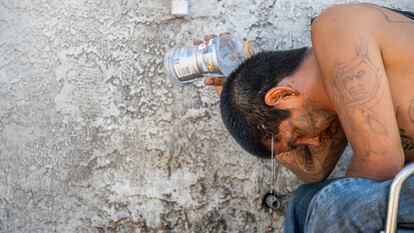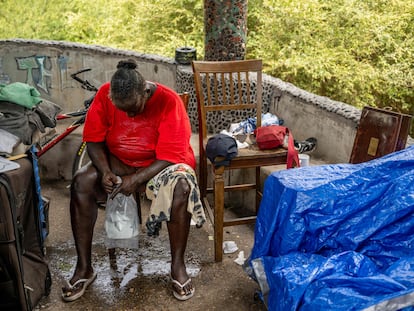The heat that is coming for us
Why aren’t we preparing for the extreme heat that awaits us? On one side, there are the climate deniers who don’t think that there’s anything to worry about, and on the other side, there are the activists committed to preventing environmental disaster

We are going through the hottest season in modern history. Throughout June and July, global average temperatures have exceeded all previous records. Prolonged heat waves have been experienced around the world, the water in the North Atlantic is unusually warm (there’s fear that one of its crucial sea currents may collapse sooner than expected) and Antarctica, in the middle of winter in the Southern Hemisphere where El Niño is just beginning, has had sea ice extensions well below normal.
In Mexico, over two hundred people have died from heat stroke this summer. On the night of June 14, three members of a single family in Tabasco (a coastal state on the Gulf of Mexico) perished because there was no electricity in their neighborhood, and they decided to spend the night in their car for the air conditioning with the engine running. The current heat-related fatality figures may not seem alarming when compared to phenomena like violence and pandemics, but these climate conditions are just a modest preview of what lies ahead.
Do you remember when we used to discuss global warming caused by greenhouse gas emissions? At some point, the suspicious decision was made to speak instead of “climate change,” which is a more capacious term, but it is also more ethereal, technical, harmless. To be sure, the climate is changing in many ways, but the first and most massive manifestation of that change is heat; it’s a type of heat that the human species has never experienced before and is therefore unprepared to cope with.
In 2021, editor Sandra Barba recommended that I read Kim Stanley Robinson’s The Ministry for the Future, a climate fiction novel that begins with a scene of thermal horror: a crowd of people seek refuge inside a lake during a heat wave in India that causes over twenty million deaths. I must confess that, at the time, it seemed like an exaggerated situation to me (even though I was also writing a novel that begins with a futuristic heat wave, in which the destructive agent is not temperature but fire). Until then, I had never heard of the thermal bulb temperature, a situation of extreme humidity in which a temperature of 95 degrees Fahrenheit (35 degrees Celsius) is unbearable for the human body, so I did not imagine how close we are to that precipice.
Another recently published book confronted me with the magnitude of this threat. The title is justifiably sensationalist: The Heat Will Kill You First: Life and Death on a Scorched Planet by Jeff Goodell combines reports with popular science chapters to communicate how vulnerable we are to the extremes of heat that climate change is already causing. At the beginning of the book, there is a list of compelling data, one piece of which I highlight as highly relevant to Latin America: currently, about 30 million people live in areas of extreme heat (places where the average annual temperature reaches 86 degrees Fahrenheit, or 30 degrees Celsius); in 2070, there will be 2 billion people living in such areas. This estimate does not mean that the population will increase in those places, but rather that the hot regions will expand enormously, occupying most of India, Southeast Asia, the Sahel in Africa and tropical America. In addition to harming the health and quality of life of almost a quarter of the world’s population, it will compromise agricultural productivity, leading to climate migration and sociopolitical crises.
According to a study published in 2020 on the future of the human climate niche, the situation may become even more extreme: the temperature experienced by humans will change more in the coming decades than it has in the past six thousand years, and about 3.5 billion people will face an average annual temperature above 84.2 degrees Fahrenheit (29 degrees Celsius). Currently, such conditions are experienced on less than 1% of the continental surface, mainly in the Sahara, but by 2070 they could be found on about 20% of the world’s continental surface, including much of Latin America.
In my country, for example, the most affected areas will be the coast of the Gulf of Mexico and the Yucatán peninsula, which in recent decades has experienced explosive urbanization, spurred primarily by the Mayan Riviera’s tourist boom. A millennium ago, the Central American region experienced the civilizational collapse of Mayan cities associated with a warming that, from the European perspective, is referred to as the Medieval Climate Optimum, although it was far from optimal for Mesoamerica’s inhabitants. That background should serve as a warning.
Speaking of Eurocentric optimism, Bjorn Lomborg, a Danish critic of climate alarmism, recently declared that rising temperatures will save lives by reducing the number of deaths from the cold. That positive approach to global warming misrepresents the phenomenon, as it is only relevant to Nordic countries and not to the Asian, African and American areas, where most of the world’s population lives.
I am uncomfortable with appealing to the Mayan apocalypse because I fear that catastrophism will lead to denial and paralysis instead of collective mobilization. At this point, I would like to tell a joke to break the tension, but I can’t think of any. I have spent this summer under a brutal heat dome that has so deteriorated my quality of sleep that my sense of humor is scorched.
Why aren’t we preparing for the extreme heat to come? On one side, there are the climate denialists who don’t think that there is anything to worry about, and on the other side, there are the activists who are committed to preventing it. This year’s events make a mockery of the nonchalant stance and are an urgent call to organize to stop global warming and help those who are already suffering the most.
Sign up for our weekly newsletter to get more English-language news coverage from EL PAÍS USA Edition
Tu suscripción se está usando en otro dispositivo
¿Quieres añadir otro usuario a tu suscripción?
Si continúas leyendo en este dispositivo, no se podrá leer en el otro.
FlechaTu suscripción se está usando en otro dispositivo y solo puedes acceder a EL PAÍS desde un dispositivo a la vez.
Si quieres compartir tu cuenta, cambia tu suscripción a la modalidad Premium, así podrás añadir otro usuario. Cada uno accederá con su propia cuenta de email, lo que os permitirá personalizar vuestra experiencia en EL PAÍS.
¿Tienes una suscripción de empresa? Accede aquí para contratar más cuentas.
En el caso de no saber quién está usando tu cuenta, te recomendamos cambiar tu contraseña aquí.
Si decides continuar compartiendo tu cuenta, este mensaje se mostrará en tu dispositivo y en el de la otra persona que está usando tu cuenta de forma indefinida, afectando a tu experiencia de lectura. Puedes consultar aquí los términos y condiciones de la suscripción digital.









































